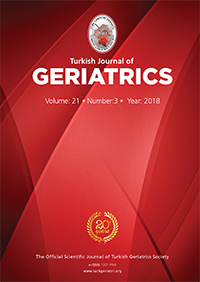2Biruni University, Health Science Faculty, Nursing Department, Ä°stanbul, Turkey
3University of Ä°stanbul, CerrahpaĹźa Medical School, Department of Internal Medicine, Division of Geriatrics, Ä°stanbul, Turkey DOI : 10.31086/tjgeri.2018344059 Introduction: The study was conducted to investigate the effectiveness of subcutaneous infusion (Hypodermoclysis) in geriatric patients with mild and moderate dehydration.
Materials and Method: This randomized controlled study to determine the efficacy of hypodermoclysis in hydration in a private geriatric care unit included 30 patients, who received both experimental and control administration. Control administration included three intravenous infusions, whereas experimental administration included three subcutan infusions.
Results: Rates of redness, bleeding and agitation were significantly higher at the administration site with intravenous infusion than with subcutan infusion method (p<0.01). By subcutan infusion, development rate of edema was significantly lower after the first administration; no edema was observed in the second and third administration. There was a statistically significant difference in the number as well as the duration and insertion times of the catheters used between the two infusion methods (p=0.001).
Conclusion: The findings revealed that hypodermoclysis was more effective than intravenous infusion based on the laboratory findings, incidence of side effects, amount and cost of consumables and catheter insertion and duration times. Therefore, hypodermoclysis can be used in mild and moderately dehydrated geriatric patients who need parenteral support.
Keywords : Nursing; Hypodermoclysis; Geriatrics; Fluid therapy
